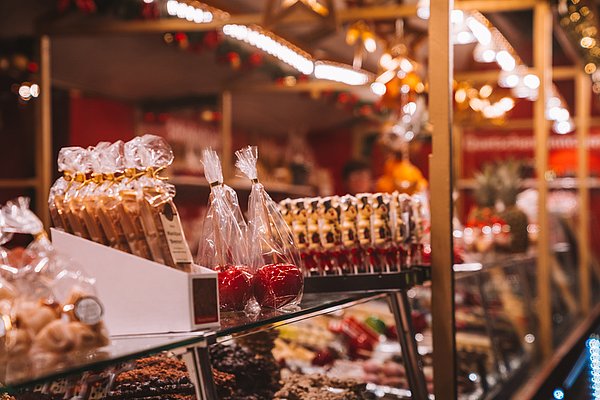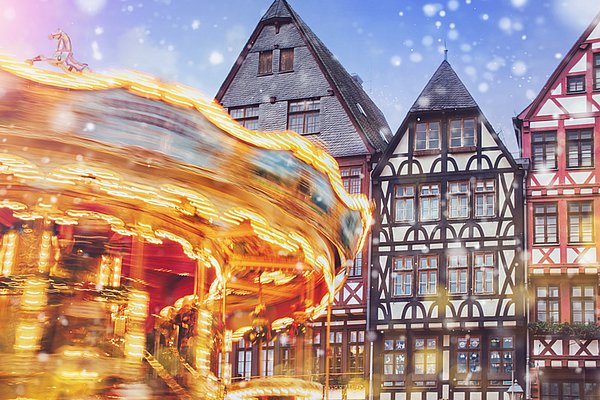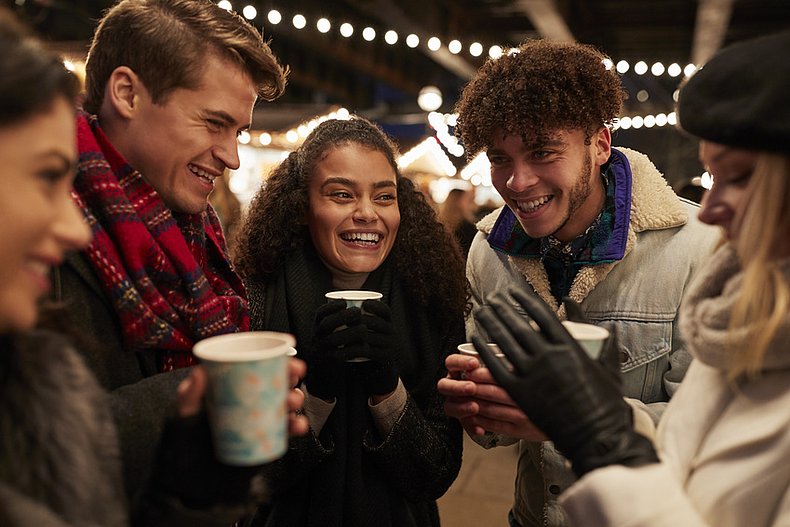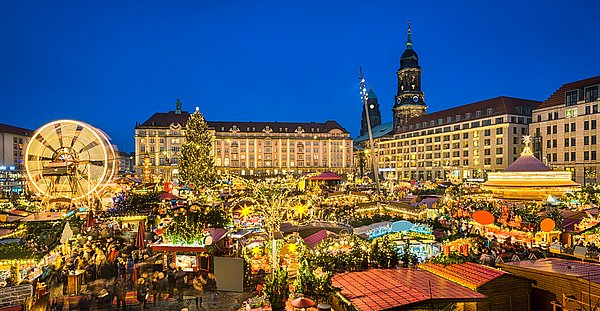Germany's 11 Most Beautiful Christmas Markets
Christmas markets are probably some of the most popular German traditions worldwide. Meanwhile, one can find them all across the world. Still, it is worth visiting some of the “originals” during your stay in Germany. There are numerous options for you to do so as almost every bigger German town is hosting one during advent season. Across the country, there are more than 2,500 Christmas markets. Traditionally, they are opening shortly after “Totensonntag”, a German holiday in commemoration of the death held on Sunday before the first advent. In 2018, this is November 25. For some years from now, some advent markets are starting earlier though. Usually, the markets close on Christmas holidays but some also stay open until New Year’s Eve or even epiphany, January 6. Smaller or theme Christmas markets sometimes even just open for a single weekend. Often, the rather unknown markets of small towns are the ones built particularly carefully. Therefore, these are usually especially cozy and attractive. To get to know some of those insider tips in your area, you should just keep your eyes and ears open. Still, there are some Christmas markets known in the whole country and we are willing to present you a small selection of them. Thereby, the listing order is not a ranking, as everybody has to decide separately which kind of advent market he or she prefers.
History and Origin
Christmas markets have their origin in the late Middle Ages. Back then, there already were some small markets and trade fairs where people could provide themselves with enough clothes and food for the cold part of the year. In the 14th century, the markets were expanding for instance with manufacturers who produced toys. Their products have been bought as presents for the children. Almost simultaneously, the first salespersons of food and beverages, for instance confectioners and those selling roasted almonds or chestnuts as we still see them today, appeared. This custom became regular all over the German-speaking part very quickly. Since around the first half of the 20th century, Christmas markets are a fixed part of German pre-Christmas-period-traditions. Depending on each region, they are also known as advent or “Christkindl” (Christ child) markets.
Classics of Christmas Markets

A Christmas market usually consists of lots of small huts or stalls offering different products. Often, these are handicraft stalls or huts selling typical Christmas decoration like Christmas baubles or cribs but usually some also sell clothes, candles and jewelry that make good presents. In many cities, there is a cultural framework program as well. This can consist of petting zoos with for example donkeys and sheep, appearances of orchestras, chores, or Santa Claus himself. The area in which the markets are built are usually trimmed lushly with lots of fairy lights, Christmas decoration and fir trees making visitors feel like walking through a winter-wonder-land. For many Germans, the true highlight of the markets are the sale spots of food and beverages though. For those who love hearty food, there are pans of mushrooms, German “Bratwurst” (fried sausages) and stuffed handmade bread but also fried potato patties mostly served with apple purée or sugar beet syrup. Coming to the sweet culinary delights that are part of every Christmas market, besides the traditional roasted almonds and chestnuts, there are “Lebkuchen” (a kind of ginger bread), "Mutzen" (German pastries, comparable to small, round donuts), crêpes, candy apples and fruits coated with chocolate. It is obligatory to try the mulled wine. Made with Christmassy spices and fruits, this hot drink normally consists of red wine but there are variations made with white wine as well. You can also try the mulled wine with a rum-soaked sugarloaf lit above it, cocoa (with or without a lacing of alcohol) or apple punch. Of course, the markets offer cold drinks like lemonade or beer as well.
1. “Dresdener Striezelmarkt” (Saxony)
Ever since 1434, the so-called “Striezelmarkt” brings numerous visitors to the old market in the city of Dresden. As most of the salespersons are from Saxony themselves, the bulk of the products offered here is authentic. A special highlight is the so-called “Stollenfest” taking place on December 8. Here, people are celebrating the traditional sweet bread “Stollen” by serving an extreme huge version of it. The Christmas market opens from November 28 until December 24.
2. “Christkindlesmarkt Nürnberg” (Bavaria)
Ever since 1434, the so-called “Striezelmarkt” brings numerous visitors to the old market in the city of Dresden. As most of the salespersons are from Saxony themselves, the bulk of the products offered here is authentic. A special highlight is the so-called “Stollenfest” taking place on December 8. Here, people are celebrating the traditional sweet bread “Stollen” (Link zum Essensartikel) by serving an extreme huge version of it. The Christmas market opens from November 28 until December 24.
3. Christmas Market and Christmas Forest Goslar (Lower Saxony)
Not only since declared part of the World Heritage Site, the stunning beauty of the old town of Goslar is officially confirmed. From November 28 until December 30, there are about 80 market stalls surrounded by a magical fir tree forest placed in the middle of its picturesque setting.
4. Christmas Market Erfurt (Thuringia)
In the middle of the medieval city center of Erfurt there are not only the typical stalls but also a Christmas crib with 14 hand-carved and almost life-sized figures. The twelve-meter high, original Christmas pyramid from the Erzgebirge is another highlight of this market. Next to the dome, there is also a fairy tale forest and a petting zoo. The Christmas market opens from November 27 until December 22.
5. Christmas Market Ulm (Baden-Württemberg)
The Christmas market in the city of Ulm also offers a fairy tale forest and a Christmas crib with living donkeys and sheep. Placed perfectly at cathedral with the highest spire worldwide, the market also has a fairy tale yurt where stories and fairy tales are told on a daily basis from November 27 to December 22.
6. Christmas Market Dortmund (North Rhine-Westphalia)
Although the Ruhr-area is not particularly known for its beauty, the Christmas market of Dortmund is one of the most popular and biggest advent-markets of the whole country. Besides more than 300 stalls, it is especially the highest Christmas tree worldwide attracting lots of visitors. The market around this 45-meter high eye-catcher decorated with 48.000 lights opens from November 22 to December 30.
7. Christmas Market next to the “Römer” (Frankfurt, Hesse)

From November 26 to December 22, one of the oldest and most visited Christmas markets in Germany opens in the city of Frankfurt. It exists at least since 1393 and is located between the “Römerberg” (city hall square) and St Paul’s Square. It is popular for its regional specialties, for instance the so-called “Quetschemännsche”, small figures made from nuts, dried plums and raisins, and “Bethmännchen”, small marzipan pastry-balls.
8. Historic Christmas Market Hamburg (Hamburg)
On the city hall square of Hamburg, an “art instead of commerce”-themed, historic Christmas market takes place from November 26 until December 23. Besides the high-quality products of its stalls and the toy-alley where salesman offer toys from all around the world, it is particularly Santa Claus floating over the square in his sleigh three times a day making this market special.
9. International Christmas Market Essen (North Rhine-Westphalia)
Those of you preferring variety and diversity over classics and traditions are totally right on the international Christmas market in Essen. Located in the city center there are more than 250 stalls selling products from 20 different countries and every region of Germany. From November 16 to December 23, you can find amber jewelry from the Baltic next to handicraft from Africa, Arab falafels next to Peruvian potatoes.
10. Christmas Market Lübeck (Schleswig-Holstein)
Located in city of marzipan, the Christmas market of Lübeck is probably the best choice for all fans of the sweet treat: Instead of mulled wine, you can drink marzipan-cappuccinos, instead of candy apples, you can have marzipan-stuffed baked apples. Additionally, you can have a closer look at the production of this specialty in the traditional confectionery of Niederegger. The market opens from November 26 to December 30.
11. Medieval and Christmas Market Esslingen (Bavaria)
From November 27 until December 21 time turns back in Esslingen am Neckar: Matching the Middle Ages, imposters, fire-eaters and musicians are taking the city on a time travel. Here you can have a bath in an old wooden tub, practice your archery skills, buy handicraft from long ago, try mulled beer or venison goulash – in short, relegate yourself to the 15th century in an easy and relaxing way.
As explained above, there are lots of similarities and traditions concerning Christmas markets but also many differences. No matter which market you decide for, if you prefer driving through the country to visit as many as possible or just want to explore the market of the city you live in, we hope you are having a lot of fun getting to know this German tradition! Concluding, one can definitely say that it is always best to explore the Christmas markets with friends and not to be stressed out by the often huge groups of people. Even though it might be a little chaotic sometimes or you have to wait for your mulled wine longer than you hoped to, the German Christmas markets are definitely worth visiting.




